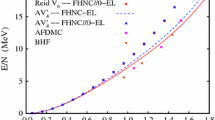Abstract.
We calculate, for the first time, the state-dependent pairing gap of a finite nucleus (120Sn) diagonalizing the bare nucleon-nucleon potential (Argonne v 14) in a Hartree-Fock basis (with effective k-mass \(m_k \approx 0.7 m\)), within the framework of the generalized Bogoliubov-Valatin approximation including scattering states up to 800 MeV above the Fermi energy to achieve convergence. The resulting gap accounts for about half of the experimental gap. The combined effect of the bare nucleon-nucleon potential and of the induced pairing interaction arising from the exchange of low-lying surface vibrations between nucleons moving in time-reversal states close to the Fermi energy accounts for the experimental gap.
Similar content being viewed by others
References
J. Bardeen, L.N. Cooper, J.R. Schrieffer, Phys. Rev. 106, 162 (1957); 108, 1175 (1957).
L.N. Cooper, Phys. Rev. 104, 1189 (1956).
H. Kamerlingh Onnes, Commun. Phys. Lab. Univ. Leiden, Nos. 119, 120, 122 (1911).
H. Frölich, Phys. Rev. 79, 845 (1950).
A. Bohr, B.R. Mottelson, D. Pines, Phys. Rev. 110, 936 (1958).
J. Dechargé, D. Gogny, Phys. Rev. 21, 1568 (1980).
R.A. Broglia, O. Hansen, C. Riedel, in Advances in Nuclear Physics, edited by M. Baranger, E. Vogt, Vol. 6 (Plenum Press, 1973) p. 287.
A. Bohr, B.R. Mottelson, Nuclear Structure, Vol. I (Benjamin, 1969).
F. Barranco et al. , Phys. Rev. Lett. 83, 2147 (1999).
To be noted that the nucleon-nucleon phase shifts which determine the bare N-N potential as well as the particle-vibration coupling strength and associated form factors can be directly derived from experiment, while this is not possible for the bare single-particle states, as only dressed nucleons are observed experimentally.
J. Terasaki, F. Barranco, R.A. Broglia, P.F. Bortignon, E. Vigezzi, Nucl. Phys. A 697, 126 (2002).
J.R. Schrieffer, Theory of Superconductivity (Addison Wesley, Redwood, 1964).
C. Mahaux, P.F. Bortignon, R.A. Broglia, C.H. Dasso, Phys. Rep. 120, 1 (1985).
A. Bohr, B.R. Mottelson, Nuclear Structure, Vol. II (Benjamin, 1975).
The formalism leading to eq. (1) is equivalent to that presented in ref. [11], which was based on Green functions, and is closely connected to that of ref. [16], based on the equation of motion method. To solve eq. (1) we have diagonalized an equivalent energy independent matrix as explained in ref. [16].
V. Van der Sluys et al. , Nucl. Phys. A 551, 210 (1993).
E. Chabanat, P. Bonche, P. Haensel, J. Meyer, R. Schaeffer, Nucl. Phys. A 627, 710 (1997). We have found it convenient to reduce the strength of the spin-orbit term by 15% in order to obtain a better overall agreement with the experimental data.
This result can be compared to a similar calculation performed with an effective mass equal to one, which gives \(\Delta \approx\) 2.2 MeV [19], a result which reflects the fact that the gap depends strongly on the density of levels at the Fermi energy.
F. Barranco et al. , Phys. Lett. B 390, 13 (1997).
D.R. Bes, R.A. Broglia, G.G.Dussel, R. Liotta, H.M. Sofia, Nucl. Phys. A 260, 1; 27 (1976).
D.R. Bes, R.A. Broglia, G.G.Dussel, R. Liotta, R.J. Perazzo, Nucl. Phys. A 260, 77 (1976).
G.F. Bertsch, P.F. Bortignon, R.A. Broglia, Rev. Mod. Phys. 55, 287 (1983).
We have only considered the renormalization of the 2+ low-lying phonon, the properties of the other phonons participating in the renormalization processes being instead taken from experiment. For simplicity, the calculations were carried out making use of a separable multipole-multipole interaction, including the modes with \(\lambda^{\pi} =2^+,3^-,4^+,5^-\). The coupling constant of the quadrupole-quadrupole component was adjusted so that the bare quadrupole vibration displayed properties similar to those calculated making use of effective interactions (i.e. \(\hbar \omega_{2^+} = 2\) MeV and \(B(E2 \uparrow) \) = 700 e2 fm4), while the other coupling constants were chosen, so as to give an overall description of the measured energies and transition strengths of the low-lying states [24].
O. Beer et al. , Nucl. Phys. A 417, 326 (1970). N.G. Jonsson et al. , Nucl. Phys. A 371, 333 (1981).
P.F. Bortignon, R.A. Broglia, C.H. Dasso, Nucl. Phys. A 398, 221 (1983).
To be noted that the anharmonic effects associated to the finite value of the quadrupole moment produce a shift of the energy of phonon, which is however very small compared to the processes already considered.
P.H. Stelson et al. , Phys. Rev. C 2, 2015 (1970).
R.Graetzer et al. , Phys. Rev. C 12, 1462 (1975).
D.R. Bes, J. Kurchan, The Treatment of Collective Coordinates in Many-Body Systems. An Application of the BRST Invariance (World Scientific, Singapore, 1990).
S. Goriely et al. , Phys. Rev. C 66, 024326 (2002).
Author information
Authors and Affiliations
Corresponding author
Additional information
Communicated by A. Molinari
Received: 3 November 2003, Published online: 6 July 2004
PACS:
21.30.Fe Forces in hadronic systems and effective interactions - 21.60.Jz Hartree-Fock and random-phase approximations - 21.60.-n Nuclear structure models and methods - 27.60. + j \(90 \leq A \leq 149\)
Rights and permissions
About this article
Cite this article
Barranco, F., Broglia, R.A., Coló, G. et al. Many-body effects in nuclear structure. Eur. Phys. J. A 21, 57–60 (2004). https://doi.org/10.1140/epja/i2003-10185-0
Issue Date:
DOI: https://doi.org/10.1140/epja/i2003-10185-0



